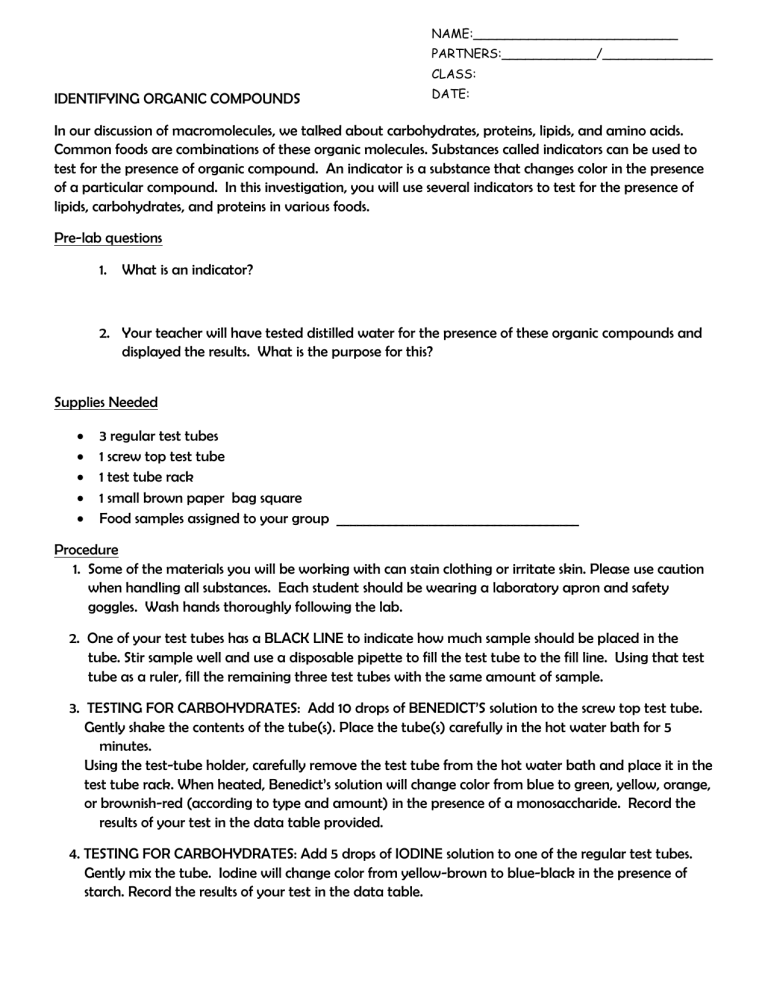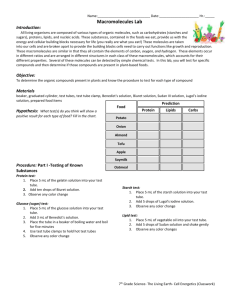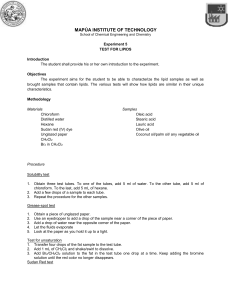Identifying Organic Compounds Lab Worksheet
advertisement

NAME:__________________________ PARTNERS:____________/______________ CLASS: IDENTIFYING ORGANIC COMPOUNDS DATE: In our discussion of macromolecules, we talked about carbohydrates, proteins, lipids, and amino acids. Common foods are combinations of these organic molecules. Substances called indicators can be used to test for the presence of organic compound. An indicator is a substance that changes color in the presence of a particular compound. In this investigation, you will use several indicators to test for the presence of lipids, carbohydrates, and proteins in various foods. Pre-lab questions 1. What is an indicator? 2. Your teacher will have tested distilled water for the presence of these organic compounds and displayed the results. What is the purpose for this? Supplies Needed 3 regular test tubes 1 screw top test tube 1 test tube rack 1 small brown paper bag square Food samples assigned to your group _____________________________________ Procedure 1. Some of the materials you will be working with can stain clothing or irritate skin. Please use caution when handling all substances. Each student should be wearing a laboratory apron and safety goggles. Wash hands thoroughly following the lab. 2. One of your test tubes has a BLACK LINE to indicate how much sample should be placed in the tube. Stir sample well and use a disposable pipette to fill the test tube to the fill line. Using that test tube as a ruler, fill the remaining three test tubes with the same amount of sample. 3. TESTING FOR CARBOHYDRATES: Add 10 drops of BENEDICT’S solution to the screw top test tube. Gently shake the contents of the tube(s). Place the tube(s) carefully in the hot water bath for 5 minutes. Using the test-tube holder, carefully remove the test tube from the hot water bath and place it in the test tube rack. When heated, Benedict’s solution will change color from blue to green, yellow, orange, or brownish-red (according to type and amount) in the presence of a monosaccharide. Record the results of your test in the data table provided. 4. TESTING FOR CARBOHYDRATES: Add 5 drops of IODINE solution to one of the regular test tubes. Gently mix the tube. Iodine will change color from yellow-brown to blue-black in the presence of starch. Record the results of your test in the data table. 5. TESTING FOR LIPIDS: Add 5 drops of SUDAN stain to one of the regular test tubes. Gently mix the contents of the tube. Sudan stain will react in the presence of a fat. Record observations and the results of your test in the data table. 6. TESTING FOR LIPIDS: Place a small drop of your food sample on the brown paper bag square and let it dry 10-15 minutes. Hold the piece of brown paper up to a bright light. The presence of a translucent spot indicates the presence of lipids. 7. TESTING FOR PROTEINS: Add 5 drops of BIURET solution to the last regular test tube. Gently mix the contents of the tube. Biuret solution changes color from blue to blue-violet or pink in the presence of protein. Record the results of your test in the data table. 8. CLEAN UP AND RETURN ALL OF YOUR MATERIALS. RESULTS Substance LIPID TEST Sudan Lipids color present (√) Iodine color CARBOHYDRATE TEST Starch Benedict Sugar present ’s present (√) color (√) PROTEIN TEST Biuret Proteins color present (√) Honey Egg white Corn oil Lettuce Milk Peanut butter Potato Apple juice Distilled water UNKNOWN 1. Which substances contain lipids? Explain your evidence. 2. Which substances contain starch? Explain. 3. Which substances contain simple sugar (monosaccharides)? Explain. 4. Which substances contain protein? ___________________________________________________ 5. Which substances did not test positive for any of the organic compounds? Explain. 6. Your brown lunch bag has a large, translucent spot on the bottom. Explain. 7. If a thin slice is removed from a peanut and treated with Sudan and Biuret solutions. Upon examination, the peanut slice has patches of red and blue-violet. What can you conclude? ____________________________________________________________________________________________





